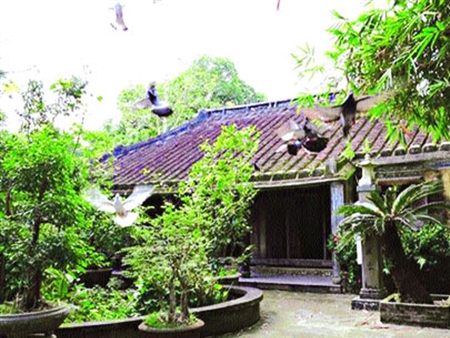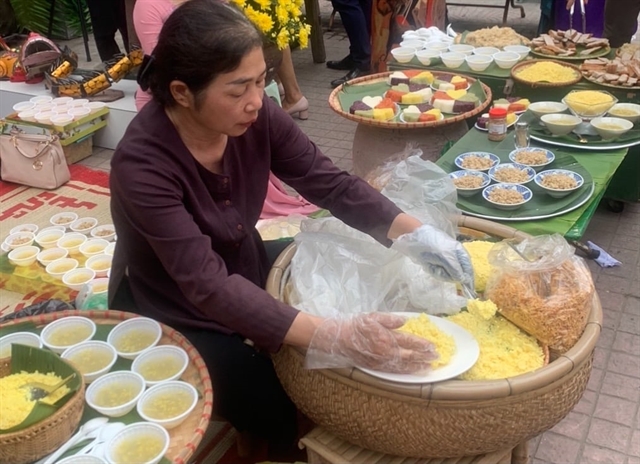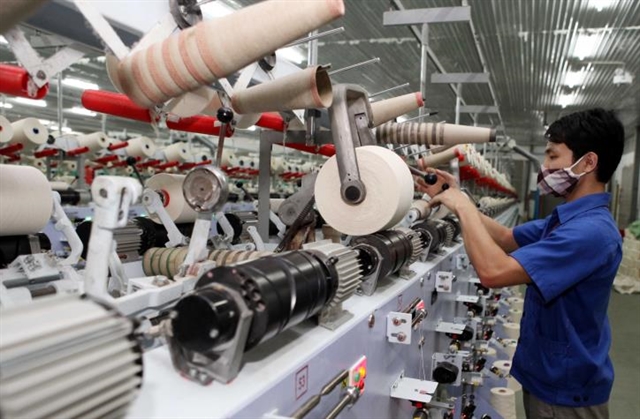

An old house has stood firm in Da Nang for many years. Members of the same family have lived in it for a long time. A ninety-year-old woman has lived in it all her life and her son now lives there too. Over the years they have done all they can to keep it looking good.
 |
| Homes of history: Ancient houses are the soul of the village. — Photos www.bookin.vn |
An old house has stood firm in Đà Nẵng for many years.
Members of the same family have lived in it for a long time.
A ninety-year-old woman has lived in it all her life and her son now lives there too.
Over the years they have done all they can to keep it looking good.
Hoài Nam
A 300-year-old house has sheltered Ong Thi Man and four generations of her family in Phong Nam Village, 20km from Da Nang City centre.
The village in the suburban Hoa Chau Commune is one of the last places that continue to preserve a rural life.
Man, 90, who was born and brought up in the village, inherited the house from her grandfather.
The ancient house, built as a ruong house (a popular design that can be seen in Hue and the central region with ironwood columns, girders and clay-baked roof tiles), is seen as one of the oldest houses in the village.
"I have been living in the house since my birth. The house witnessed the prosperous life of our family during my grandfather’s time, and now my son’s," Man said.
"I have tried to preserve the house for years, but I’m too old to maintain it anymore. My son will continue to preserve it," she said.
"I will donate it to the village as a museum if it is renovated for prolonged use."
The 14th century village saw northerners migrate to the south after the Ho dynasty (1400-07).
The northerners found and settled in the village on the Yen River bank and 13 clans have been living here in peace since then.
Ngo Van Nghia, 73, who belongs to the 14th generation of the Ngo clan, said the villagers originally came from Thanh Hoa Province.
He said the area and the central region were under the rule of Champa Kingdom (between the fourth and 13th centuries).
"The village is seen as the last ancient village that exists in the suburban area of Da Nang. Old houses have been rapidly replaced by new ferro-cement houses after fast urbanisation in the city over the past two decades," Nghia said.
"Many centuries-old houses were there in the 1975-1990 period, but only four old houses exist now. Mao’s house is the oldest with the original architecture," Nghia said.
Mao’s only son Bui Trong Trung, 45, said he was the fourth generation to live in the house.
"It was built by my great grandfather in the old ruong style. All eight wooden columns and doors have been preserved with rammed clay floors. We have replaced only one rotten column and repainted the walls for long-term use," Trung said.
"The timber structure and clay roof kept the house cool in summer and warm in winter," Trung said.
"Now I have built a new house with better accommodation, but we have preserved the old house as a family memory. However, the house is in ruins as the mortar on the exterior has scaled off, and roof will collapse soon."
Trung said the preservation of the house cost a lot of money, while he only made both ends meet as a lorry driver.
Ngo Thi Thuy Nhu, 52, still preserves her great-grandmother’s house in Phong Nam Village.
She said the house was renovated several times, with tiles replacing the original clay floor.
"Only the original roof, timber columns and girders have been retained. We use it as a place of worship because we have built more convenient three-storey houses," Nhu said.
She said the house symbolised the history of the village and defunct rural lifestyles of the 15th century.
Wood and other materials collected from jungles have helped to preserve old houses through centuries.
Legends and deities
Nghia, who is in charge of the culture section of the village, said northerners - the ancestors of the present generation - brought seven bronze Buddha statues during their migration to the south from the 15th century.
"Traditionally, northerners often build pagodas and temples in new settlements for their religious beliefs. The Buddha statues are the most important spiritual factors of a pagoda," he said.
"Local villagers buried these statues or hid them in safe places before they fled during wars. An excavation in the 1960s unearthed four statues, and one was kept by a local resident, while two statues went missing," Nghia said.
He said four life-size Buddha statues were kept at Hoa Tho Tay pagoda in Hoa Vang District as treasures of the village’s history.
According to Ngo Tat Hien, 63, the village originated from the worship of the god of farming or agricultural deities and a legend of buffalo boys.
He said rice farming was a major occupation of the village as the Yen River enriched the land with lucrative alluvium.
"The legend of the farming god was passed down from generation to generation through oral tradition. A temple of agricultural deities existed till the late 1930s," Hien said.
He said there was a legend about an old and strange man who came to the village. He was loved by poor buffalo boys. The old man was buried in a hill when he died. The hill then became a rendezvous for buffalo boys.
Villagers thought it was a land of genies, and a festival for buffalo boys was born.
Hien said in the feudal period, buffalo boys often were from poor families or orphans, and had to work for landlords. Poor boys used to live and work in poor conditions and in hunger, and the festival was initiated to honour buffalo boys and farmers.
He said the Muc Dong (buffalo boys) Festival was introduced on the lunar April 4 in 1936 under the reign of King Bao Dai, and then it was organised every three years.
The festival was interrupted for years due to war, until 2007, when it was revived with funding from Viet Nam’s Folk Arts Association, before the central city’s culture, sports and tourism department started hosting it in 2010, and villagers held it once in 2014.
Nghia, who chaired the festival, said a procession of boys wearing old costumes marched through paddy fields to the village temple.
"The festival is held in spring time to wish for a bumper harvest, when farmers start preparations for a new crop. People believe that the crops in farms through which the procession passes will grow well," he said.
"Folk games and tuong (classic drama) performances are held during the festival."
Deputy Director of the city’s culture, sports and tourism department Tran Quang Thanh said the festival was seen as an old cultural event in honour of farmers.
He said the department had been seeking funds to hold the festival every three or five years, and to maintain old houses.
Nguyen Dac Lam, 14, who acted as a buffalo boy, said he was very excited with the festival and the legend of buffalo boys.
"We were told the legend during a course in the village, and we acknowledged the poor and hard life of buffalo boys. They (buffalo boys) also contributed a large share towards the bumper harvests in previous centuries," Lam said.
He said the festival was not only a cultural festival, but told the history of the land where he was born and grew up in.
Nghia, the event chairman, said the cultural event helped children to recognise the old style of festivities that have partly disappeared due to rapid urbanisation.
Better incomes
Industrial parks have developed where paddy fields once stood, reducing the farming area from 160ha to 60ha over the past two decades. The 2,300-strong population in the village rarely does rice farming, but earns better income from trade or by working in industrial parks surrounding the village.
Lorry driver Trung said, "Only women do farming now as the land was allocated by the village administration. Small farms bring us very little rice, but we do not keep the land fallow.
"However, we do everything to preserve my old house that sheltered my family. It’s a precious memory and an exhibit of my village. I’m proud of that."
Nguyen Binh, chairman of Hoa Chau Commune, said the preservation of old houses in the village required large amounts of funds and long-term planning.
Villagers worry that the 1936-built village’s temple, which was occupied by a primary school 10 years ago, is not accessible whenever a festival is held.
"A two-storey house was built in the temple’s front yard, and villagers have no way to approach the temple. We have to go through the school yard to approach the temple," Hien said.
The village chairman said he had been negotiating with the school’s managing board on opening an access road for regular worshippers and festival-goers at the temple.
Urban life has changed the village a lot, with concrete roads replacing most of the brick roads.
The remnants of the old village are only old houses, temple, pagodas with Buddha statues and green paddy fields.
"Although urbanisation bringing new changes, we still try to restore and preserve the culture of the village and the precious tangible and intangible value of culture that was built by our ancestors," Nghia said. — VNS
GLOSSARY
A 300-year-old house has sheltered Ong Thi Man and four generations of her family in Phong Nam Village, 20km from Da Nang City centre.
You and your brothers and sisters are one generation; your parents and their brothers and sisters --- your aunts and uncles – are another generation and their parents and their brothers and sisters – your grandparents and your great aunts and great uncles – are yet another generation, and so on.
The village in the suburban Hoa Chau Commune is one of the last places that continue to preserve a rural life.
To preserve means to keep.
A rural life is a country life.
Man, 90, who was born and brought up in the village, inherited the house from her grandfather.
To inherit a house means to be given a house because the last owner has left it for you after he, or she, dies.
The ancient house, built as a ruong house (a popular design that can be seen in Hue and the central region with ironwood columns, girders and clay-baked roof tiles), is seen as one of the oldest houses in the village.
Ancient means very old.
A girder is a large steel frame.
"The house witnessed the prosperous life of our family during my grandfather’s time, and now my son’s," Man said.
Prosperous means healthy and wealthy.
"I have tried to preserve the house for years, but I’m too old to maintain it anymore. “
To maintain a house means to keep it in good shape.
"I will donate it to the village as a museum if it is renovated for prolonged use."
To donate means to give.
To renovate a building means to fix up and change it, often by making it more modern.
Prolonged means made longer, in other words so that it can be used for longer.
The 14th century village saw northerners migrate to the south after the Ho dynasty (1400-07).
When people migrate they move from one place to another in large numbers.
The northerners found and settled in the village on the Yen River bank and 13 clans have been living here in peace since then.
Clans are groups of families that are mostly related to one another.
The village is seen as the last ancient village that exists in the suburban area of Da Nang.
A suburban area of Da Nang is a neighbourhood within the city.
Old houses have been rapidly replaced by new ferro-cement houses after fast urbanisation in the city over the past two decades," Nghia said.
Ferrocement is a type of reinforced concrete.
Urbanisation happens when many people leave rural areas and come to live and work in towns and cities, which are urban areas.
"Many centuries-old houses were there in the 1975-1990 period, but only four old houses exist now. Mao’s house is the oldest with the original architecture," Nghia said.
Architecture is the art of designing buildings.
"All eight wooden columns and doors have been preserved with rammed clay floors.
Rammed means stamped down very hard.
"However, the house is in ruins as the mortar on the exterior has scaled off, and roof will collapse soon."
Mortar is a building material made of sand, cement, water and other things to make bricks stick together.
If the mortar has scaled off, it has peeled off.
Trung said the preservation of the house cost a lot of money, while he only made both ends meet as a lorry driver.
To make ends meet means to make enough money to survive.
"Only the original roof, timber columns and girders have been retained. We use it as a place of worship because we have built more convenient three-storey houses," Nhu said.
If something is convenient to you, it suits your needs.
She said the house symbolised the history of the village and defunct rural lifestyles of the 15th century.
Defunct rural lifestyles are ways of life that people in the rural areas no longer live.
Nghia, who is in charge of the culture section of the village, said northerners - the ancestors of the present generation - brought seven bronze Buddha statues during their migration to the south from the 15th century.
Your ancestors are your parents, their parents and all those before them.
"An excavation in the 1960s unearthed four statues, and one was kept by a local resident, while two statues went missing," Nghia said.
An excavation means an archaeological digging.
To unearth something means to dig it up from underground.
According to Ngo Tat Hien, 63, the village originated from the worship of the god of farming or agricultural deities and a legend of buffalo boys.
Deities are gods and goddesses.
A legend is a traditional story
He said rice farming was a major occupation of the village as the Yen River enriched the land with lucrative alluvium.
Lucrative means providing wealth.
Alluvium is sand, clay and other stuff left behind by a flowing river.
The hill then became a rendezvous for buffalo boys.
A rendezvous is a meeting place.
Villagers thought it was a land of genies, and a festival for buffalo boys was born.
A genie is a magic spirit.
Hien said in the feudal period, buffalo boys often were from poor families or orphans, and had to work for landlords.
The feudal period is the time when the rich and powerful owned the land and ordinary people worked under them and had to perform duties for them, such as fighting in their wars.
Landlords are land, or property owners.
The festival was interrupted for years due to war, until 2007, when it was revived with funding from Viet Nam’s Folk Arts Association, before the central city’s culture, sports and tourism department started hosting it in 2010, and villagers held it once in 2014.
Revived means brought to life again.
"The festival is held in spring time to wish for a bumper harvest, when farmers start preparations for a new crop.
A bumper harvest happens when lots of crops are harvested.
The 2,300-strong population in the village rarely does rice farming, but earns better income from trade or by working in industrial parks surrounding the village.
Rarely means not often.
Lorry driver Trung said, "Only women do farming now as the land was allocated by the village administration.
Allocated means given.
Small farms bring us very little rice, but we do not keep the land fallow.
When land is fallow it is left without any crops being planted in it for a while.
The remnants of the old village are only old houses, temple, pagodas with Buddha statues and green paddy fields.
Remnants of an old village are things that are left behind from an old village.
"Although urbanisation bringing new changes, we still try to restore and preserve the culture of the village and the precious tangible and intangible value of culture that was built by our ancestors," Nghia said.
You can touch things that are tangible; you cannot touch things that are intangible.
WORKSHEET
State whether the following sentences are true, or false:
© Duncan Guy/Learn the News/ Viet Nam News 2016
1. True; 2. False; 3. True; 4. True; 5. False.









